Plastic
Plastic waste created at home is roughly sorted into two categories:
- plastic packaging
- plastic objects
Plastic packaging for recycling
Plastic packaging is transported via the terminal of Finnish Plastics Recycling Ltd to Fortum’s Plastics Refinery where some of it is recycled into new plastic products and the rest are utilised as energy.
You can put empty, clean and dry plastic packaging from your household into the container for plastic packaging. Make sure that all lids and bottle tops are separated from their containers.
Examples of plastic packaging suitable for recycling:
- Food and detergent packages
- Plastic bags and wrapping
- Plastic bottles, canisters and tubs
- styrofoam packages (styrofoam used in construction is sorted into combustible waste)
If the packaging cannot be cleaned by rinsing, it must be sorted into combustible waste. If waste is washed with warm water, the environmental benefits pursued by recycling are not achieved.
Etappi collects households’ plastic packaging for recycling. We organise a separate collection in the population centres of Ilmajoki, central Kurikka, Lapua and Seinäjoki for housing associations with at least 20 apartments. Smaller housing associations and groups of detached houses in these areas can join the refuse collection service, if they wish.
Households that fall outside the sphere of separate collection can take their plastic packaging waste to one of Etappi’s waste stations free of charge.
The producer organisations of the packaging waste are responsible for its collection and recycling. Finnish Packaging Recycling RINKI Ltd carries out the collection on their behalf. Households can also take their plastic packaging waste to a Rinki eco take-back point.
Sorting plastic packaging is voluntary for the inhabitants of the municipalities in Etappi’s area. If your municipality of residence has no collection point for plastic or those it has are not close enough to your property, the plastic packaging must be sorted into combustible waste.
Plastic items sorted into combustible waste

Plastic items refer to other small or large plastic products found at home that are not packaging or that were bought empty.
- For example, a bucket and freezer container are plastic items and not packaging because they were bought empty.
- Since there is no specific recycling channel for plastic items, they are not collected separately.
Plastic items are sorted into the home’s container for combustible waste or taken to a waste station. Dirty plastic packaging is also put in the container for combustible waste because it cannot be recycled.
PVC

Small PVC products, such as toys, waterproof clothing and tablecloths made of coated fabric (oilcloth) may be put in the container for combustible waste, i.e. your home container, as individual items. Large products containing PVC and large batches of PVC products must be taken to a waste station where they will be sorted for treatment. For example, pipes, electrical cables, hoses and tarpaulins are waste subject to treatment and they must be taken to a waste station. PVC can be identified by the recycling code 03.
Is your waste plastic or metal?
Carry out a squeeze test to find out. Squeeze the piece of rubbish to make it smaller. Let go and see if it stays crumpled up or if it uncrumples. If it starts to gradually uncrumple, it is mostly made out of plastic and must be sorted into the home’s container for combustible waste or the container for plastic packaging. If it stays crumpled up it is made out of metal and must be sorted into metal rubbish.
Plastic items include, for example, coffee packages, crisp bags and blister packs for medicine. Metal items include the foil lids of yoghurt tubs and some food containers for pet food.


